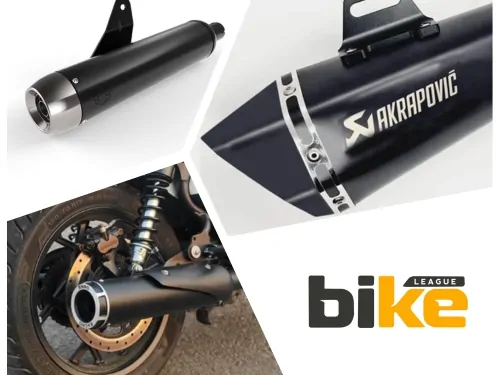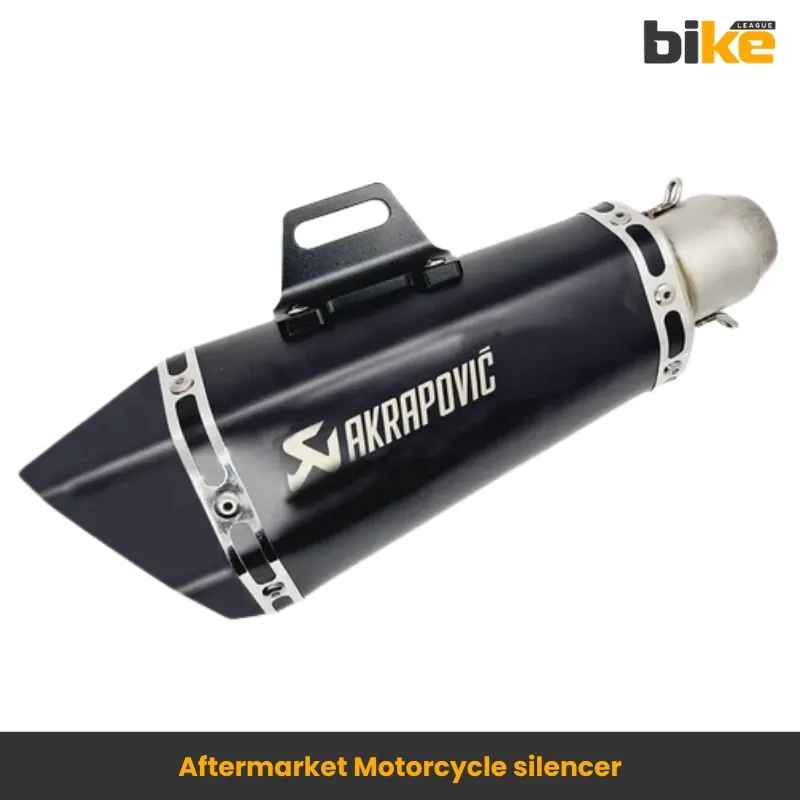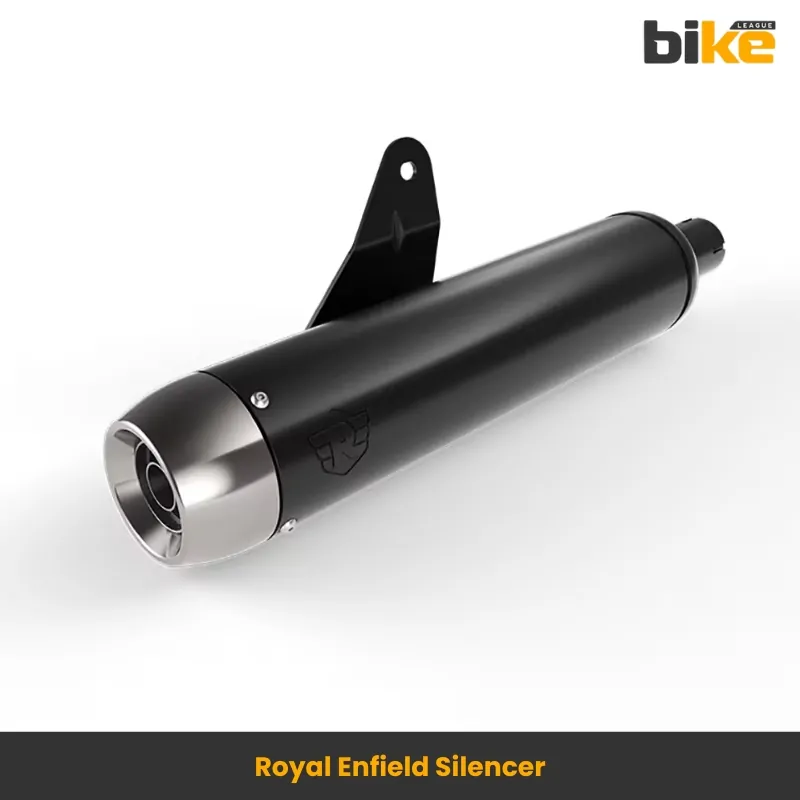
Long story short: Understand the legal aspects of aftermarket motorcycle silencer/exhaust in India. Check RTO guidelines, pollution limits, and penalties for non‑compliance.
There is a lot of confusion in the air regarding the legal and illegal use of Aftermarket motorcycle silencers in India. Yes. In this article, we are going to discuss each aspect in detail, including rules, pollution and noise limits, etc. Many people think that OEM-provided silencers are illegal, and it is actually the other way around. So it’s time to get rid of doubts in the air.
Key Takeaways
- A motorcycle silencer is part of the exhaust system that reduces engine noise by guiding exhaust gases through various chambers and baffles.
- Aftermarket silencers are non-original exhaust parts made by companies other than the motorcycle’s manufacturer.
- OEM stands for Original Equipment Manufacturer. This term means the company originally makes the motorcycle or its components.
- In India, using an OEM-approved aftermarket silencer is legal if approved by the Regional Transport Office (RTO) and complies with the 80-decibel noise limit under the Motor Vehicles Act.
- ISI-approved aftermarket silencers can be used in India if they meet legal noise and pollution standards.
What is a silencer on a motorcycle?
A motorcycle silencer is part of the exhaust system that reduces engine noise by channelling exhaust gases through chambers lined with sound-absorbing materials. Hence, the exhaust is much quieter by the time it leaves the pipe.
Functions of Motorcycle Silencer
- The main job of a silencer is to make the motorcycle much quieter, so it doesn’t disturb people nearby and follows the law. It makes the ride more pleasant for both the rider and those around them.
- A good silencer helps the engine run smoothly and can improve fuel efficiency for better mileage and performance.
- Besides reducing noise, a well-designed silencer supports cleaner emissions and can enhance performance.
Structure and Working
- Inside, exhaust gases pass through tubes, chambers, and sometimes special fibres that absorb or scatter sound for quieter operation.
- Some silencers use designs or materials to absorb or cancel out sound, even turning sound into heat.
- Modern silencers may include a catalytic converter to clean exhaust gases and a DB killer for further noise reduction.
Common Types
- Slip-on silencer: An easy-to-install silencer that replaces the stock silencer to modify the sound and performance.
- Full exhaust system: Replaces the entire stock silencer system for greater performance gains.
Materials Used
Manufacturers usually make silencers from materials such as stainless steel, carbon fibre, or titanium. These materials are strong, look good, and don’t add much weight to the bike.
The silencer is integral to a motorcycle—keeping it quiet, running smoothly, and often contributing to its style.
What are aftermarket silencers for motorcycles?
Companies other than your bike’s manufacturer make aftermarket silencers and sell them as add-ons or replacements to alter your bike’s sound, look, or performance.
In India, aftermarket silencers must comply with the law—they can’t exceed 80 decibels. If they’re too noisy and not officially approved, they’re illegal. Some aftermarket silencers lack essential parts that help control pollution, so the law does not allow them.
It’s legal to buy and sell aftermarket silencers in India, but using them on the road without meeting legal requirements has consequences. If your silencer is too loud or doesn’t comply with pollution rules, you may face fines, your bike could be seized, or you might encounter further legal penalties.
What is BS in motorcycles in India?
In India, “BS” means Bharat Stage—a set of government rules limiting vehicle pollution to help reduce air pollution and protect health.
Key Points about Bharat Stage (BS) Norms
- These Bharat Stage rules have gotten tougher over the years. For example, BS6 is the latest version and has been required for all new motorcycles in India since April 2020.
- The rules are based on similar ones used in Europe, but they’re adjusted to fit India’s needs.
- The Central Pollution Control Board (CPCB), under the Ministry of Environment, Forests, and Climate Change, implements and updates BS norms nationwide.
- BS6 rules are strict about how much pollution a bike can make. To meet these rules, bikes need special technologies that help keep the air cleaner, such as fuel injection and catalytic converters.
Purpose and Impact
- Bharat Stage rules change how bikes are designed and the technologies they use. They also determine how much exhaust a bike can legally emit.
- Manufacturers can sell and register vehicles in India only if the vehicles meet the current BS emission standard.
- Following these rules is suitable for everyone—it keeps the air cleaner and helps people stay healthier.
How are the BS and silencer connected in motorcycles in India?
On Indian bikes, the silencer reduces noise and helps meet pollution laws. Manufacturers design modern units to comply with sound and emissions regulations.
How Silencer and BS Norms are Connected
- The silencer enables a motorcycle to meet legal noise and emissions standards, such as by using catalytic converters that keep exhaust within regulatory limits.
- Because the latest pollution rules are strict, silencers now often have extra parts inside—like catalytic converters and sensors—that help clean up the gases even more. These upgrades make sure the bike passes the toughest tests.
- Installing a non-compliant or illegal silencer can result in a motorcycle failing pollution tests and being considered unlawful for road use in India.
Regulatory and Technical Changes
- As the rules have gotten stricter, silencers have changed. Most manufacturers make BS6 silencers heavier and with more complex internal parts than older models because they need to remove more pollutants.
- You meet legal standards only when you use manufacturer-approved silencers. If you use unapproved versions, you risk fines, seizure, and failing tests under Indian law.
- Altering or replacing the silencer without proper authorisation can lead to legal violations by breaching noise and emission rules.
What is OEM in motorcycles?
OEM in Indian motorcycles means Original Equipment Manufacturer: the company making the motorcycle or its initial parts. The brand manufactures or approves OEM parts, such as silencers or brakes, to meet stringent standards.
Manufacturers design OEM parts to fit specific models, which ensures reliability, safety, and legal compliance. If you use OEM parts, you keep your bike’s performance and value. People use aftermarket parts from third-party companies to replace or upgrade their bikes.
Can we use an OEM-approved aftermarket motorcycle silencer in India as per the law?
In India, it is only legal to use an OEM-approved aftermarket silencer on motorcycles if it is officially approved by the Regional Transport Office (RTO) and meets the Motor Vehicles Act regulations. Using one that is not approved or exceeds the noise limit can result in penalties such as fines, vehicle impoundment, or legal proceedings.
If a silencer exceeds the noise limit, authorities can fine you, impound your vehicle, or take other legal action. Accessories approved by automakers, including those from authorised brands like Royal Enfield and KTM, are legal and help owners avoid penalties.
Key points
- Aftermarket silencers that are not certified or approved by the RTO (Regional Transport Office) are illegal to use. Using illegal silencers can lead to significant legal consequences, including fines and possible vehicle impoundment.
- The noise level should not exceed 80 decibels as per the Central Motor Vehicles Rules and the Motor Vehicles Act.
- If you use loud aftermarket silencers, you risk penalties such as fines up to ₹10,000, vehicle seizure, and driving license suspension.
- Silencers that comply with BS6 emission norms and do not remove or tamper with catalytic converters are preferable.
- Many police departments in India are cracking down on illegally modified silencers because they are concerned about noise pollution.
- Aftermarket silencers remain legal if reputable manufacturers sell and officially approve them through their accessory programs.
You must get an RTO- and OEM-approved aftermarket silencer that meets noise and emission norms, and ideally buy it as an authorised accessory from the motorcycle brand or a verified supplier. If you don’t follow these requirements, authorities may fine you, seize your vehicle, or take further legal action.
Where can we find OEM-approved aftermarket motorcycle silencer in India?
For those seeking these products, OEM-approved aftermarket silencers are available through several channels in India.
- Authorised dealerships or accessory stores of motorcycle brands like Royal Enfield and KTM, which sell officially approved aftermarket silencers designed for their bikes.
- Reputed aftermarket silencer manufacturers and sellers who provide silencers with RTO or ARAI approval and compliance with noise and emission norms.
- Online marketplaces such as IndiaMART and JustDial, and specialised bike gear stores that list OEM- or compliant-silencer options.
- Some well-known brands and manufacturers in India for silencers include Silman, Surya Silencer, AEW India, and Royal Enfield’s official accessory line.
- Workshop service centres authorised by bike manufacturers where OEM-approved accessories, including silencers, are sold and installed.
Choosing an OEM-approved aftermarket silencer with verified RTO approval and compliance certificates is essential to ensure your motorcycle stays legal, maintains optimal performance, and supports environmental responsibility—giving you confidence and peace of mind on every ride.
Examples of sources
- Royal Enfield official accessories store
- IndiaMART sellers like Silman, Surya Silencer
- AEW India online store for bike exhausts
- Local authorised dealers of major motorcycle brands.
How are noise limits and aftermarket motorcycle silencer connected in India?
In India, there are strict rules about how loud a motorcycle can be. All silencers—including aftermarket ones—can’t make more than 80 decibels of noise when measured from 2 meters away. These rules are there to help keep noise pollution under control.
But the problem is, most aftermarket silencers are way louder than the legal limit—sometimes over 100 decibels. That makes them illegal. If you use a silencer that’s too loud, you could get fined, have your bike taken away, or face other penalties. The amount you might have to pay can be anywhere from ₹1,000 to ₹10,000, depending on where you are and how severe the violation is.
Can you use ISI-approved aftermarket silencers on motorcycles in India?
Yes, you can—but only if the silencer also meets the legal limits for noise and pollution.
The ISI mark indicates that the silencer meets the Bureau of Indian Standards’ quality and safety standards. But just having the ISI mark isn’t enough—the silencer also has to be quiet enough (under 80 decibels) and meet all the pollution rules.
The truth is, most aftermarket silencers in India don’t even have the ISI mark, and many are too loud. That makes them illegal—even if they’re good quality. So, while the ISI mark is a good sign, it’s not enough: the silencer must also be RTO-approved and follow all the noise laws to be legal on public roads.
Comparison of OEM Silencer (Stock), Legal Aftermarket Silencer and Illegal Aftermarket Silencer In India
| Aspect | OEM Silencer (Stock) | Legal Aftermarket Silencer | Illegal Aftermarket Silencer |
|---|---|---|---|
| RTO Approval | Always approved, comes with vehicle | Must have RTO/type approval | No RTO/type approval |
| Noise Limit (dB) | Strictly within prescribed norms ( less than 80dB) | Must be less than 80dB (tested) | Exceeds 80dB, often much louder |
| Emission Compliance | Meets BS6/ARAI/ISI standards | Must retain catalytic converter, meet emission norms | No catalytic converter/not meeting emission norms |
| Warranty Impact | Full warranty preserved | May void warranty if not OEM-approved | Voided warranty |
| Documentation | Vehicle registration, factory certificates | Invoice, RTO certificate, DB norm certificate | No valid documentation |
| Sale/Usage | Fully legal for public roads | Legal only if all approvals intact | Illegal to use on public roads |
| Police Action | Never penalized | Not penalized if compliant | Fined, seized, or destroyed |
| DB Killer Presence | Not required (meets norms by design) | Mandatory to keep effective DB killer | DB killer removed/absent |
| Track/Private Use | Allowed anywhere | Can be used for track/private events if meeting norms | Public use illegal even for events |
Are there any aftermarket motorcycle silencer brands or models that are known for following India’s noise and pollution rules?
Yes, in India, you can find aftermarket silencer brands and models that comply with noise and pollution regulations. These brands ensure their silencers stay below the 80-decibel noise limit and meet BS6 emission standards.
Here are a few popular and trusted brands:
- Silman Silencers (Indian manufacturer) – no direct official website, but available through IndiaMART: https://www.indiamart.com/silman-products/
- Surya Silencer (Indian brand) on IndiaMART: https://www.indiamart.com/surya-silencer-products/
- AEW India (aftermarket exhausts and silencers): https://aewindia.co
- Royal Enfield Genuine Accessories (OEM-approved accessories): https://www.royalenfield.com/in/en/gma/black-and-silver-tapered-silencer-1990726/
- TAB Performance (international brand with presence in India): https://www.tabperformance.com
- IndiaMART motorcycle silencers catalogue (various Indian suppliers): https://www.indiamart.com/impcat/motorcycle-silencer.html
These are some well-known brands and sources that offer silencers compliant with Indian regulations. Before you buy a silencer, check that it has the proper certificates and approvals. By doing this, you make sure you get a legal aftermarket silencer that’s safe for your bike.
When choosing an aftermarket silencer in India, it’s crucial to look for:
- RTO or ARAI (Automotive Research Association of India) approval.
- Compliance with noise limits (80 dB or below).
- Retention of catalytic converters for BS6 emission compliance.
Using authorised, compliant silencers reduces the risk of fines and legal issues related to noise pollution laws and emission regulations.
What specific process must be followed to obtain an aftermarket motorcycle silencer approval from the RTO?
To get an aftermarket silencer approved by the Regional Transport Office (RTO) in India, the process generally involves the following steps:
- Research and Select a Compliant Silencer: Choose an aftermarket silencer that complies with the Central Motor Vehicles Rules—specifically noise levels (below 80 decibels) and emission norms (BS6 compliant with a catalytic converter intact).
- Obtain Manufacturer’s Compliance Certificate: Get a certificate or document from the silencer manufacturer stating its compliance with noise and emission standards. This may include test reports from authorised labs, such as the Automotive Research Association of India (ARAI).
- Application to RTO: Submit an application to the local RTO where the motorcycle is registered. This application typically includes:
1. Vehicle Registration Certificate (RC).
2. Purchase invoice for the aftermarket silencer.
3. Compliance certificate from the manufacturer.
4. Identity and address proof of the vehicle owner. - Physical Inspection and Testing: The RTO may require a physical inspection of the vehicle with the new silencer fitted. They may conduct noise-level testing with a decibel meter to verify compliance.
- Modification Approval: If your silencer passes inspection, the RTO will approve or endorse the modification and update your vehicle’s records.
- Update Registration Certificate: Officials may update the RC to reflect the new exhaust or silencer, which officially legalises the modification.
- Keep Documents Handy: Carry all approval documents and certificates at all times to avoid fines or legal issues during police checks.
Can you get in trouble for using an aftermarket silencer that’s quiet enough but not approved by the RTO?
Yes—you can still get into trouble in India if you use an aftermarket silencer that’s quiet but hasn’t been officially approved by the RTO.
Key points include:
- You could be fined anywhere from ₹1,000 to ₹10,000, depending on where you live and the local rules.
- The police can take away your motorcycle if you have a silencer that isn’t RTO-approved, even if it’s not too loud.
- If you keep breaking the rules, you might end up in court or even lose your license.
- You must get RTO approval to legally use a different silencer. Just being quiet isn’t enough—the paperwork matters too.
- Some places are stricter than others, so what happens can depend on where you ride.
So, always make sure your aftermarket silencer is not just quiet, but also officially approved by the RTO to avoid fines or hassles.
How can you check if an aftermarket silencer is really RTO-approved?
Here’s how you can make sure you’re getting a real, RTO-approved aftermarket silencer in India:
- Ask for official papers: Get the RTO approval certificate or Certificate of Conformity (CoC) from the seller. This should clearly state that the silencer meets noise and emissions regulations, and it should be issued by the RTO or a trusted body such as ARAI
- Look for certification numbers: Make sure the silencer has a registration or approval number printed on it or on the box. You can double-check these numbers with the RTO or the company that made it.
- Check with the manufacturer: Ask the silencer’s manufacturer (or an official dealer) to confirm that what you’re buying is actually approved and that the paperwork matches the product.
- Ask the RTO: Some RTO offices publish a list (in person or online) of silencers they have approved. Contact your local RTO or check their website to see if your silencer is on the list.
- Check the paperwork: Good sellers will provide receipts, warranty cards, and information leaflets that mention approval and rules. Make sure everything matches up.
- Stick with trusted sellers: Buy from well-known dealers or official stores—places that clearly state the silencer is RTO-approved and provide proof.
If you follow these tips, you’ll be much less likely to get a silencer that’s not allowed, and you’ll avoid problems during police checks or inspections.
What special technologies or materials do BS6 silencers use to meet India’s strict pollution rules?
BS6-compliant motorcycle silencers use smart technology and new materials to help bikes meet India’s strictest pollution standards.
Key BS6 Silencer Technologies
Catalytic converter built in
BS6 silencers have a catalytic converter inside. This part uses special metals to turn harmful gases from the engine into cleaner gases before they leave the exhaust pipe.
An oxygen sensor to check the air quality
These silencers also have an oxygen sensor that measures exhaust oxygen content. This helps the engine use just the right amount of fuel, so it burns cleaner and pollutes less.
Materials Used in BS6 Silencers
Strong, thick metal build
Manufacturers make most BS6 silencers from thick, high-quality metal that resists rust and withstands high temperatures. This helps them last longer and work well.
Rust-resistant finish
Some companies add a special coating to stop the silencer from rusting, which is really useful in India’s weather.
High-quality original parts
BS6 silencers use high-quality parts that fit perfectly and help the bike comply with all noise and pollution regulations.
Performance and Compliance Features
Parts inside to reduce noise
New BS6 silencers feature improved internals to keep the bike quiet without compromising engine performance.
Official approval stamps
Manufacturers usually affix official stamps or labels to BS6 silencers to confirm compliance with RTO approval requirements.
All these smart features and strong materials help BS6 silencers keep bikes clean, quiet, and running well for a long time—while staying within India’s latest rules.
FAQ about Aftermarket Motorcycle Silencer in India
1. Are aftermarket silencers legal in India?
No, most aftermarket silencers aren’t legal unless they meet the noise and pollution rules set by the RTO and have the proper approvals. If you use a silencer that’s too loud or not approved, you could get fined.
2. What is the permissible noise limit for motorcycle exhausts in India?
All motorcycles must keep their exhaust noise below 80 decibels, measured at 2 meters.
3. Can police seize my motorcycle for using an aftermarket silencer?
Yes. If your silencer is too loud or doesn’t have RTO approval, the police can fine you (anywhere from ₹500 to ₹10,000), take your bike, or even destroy the silencer.
4. Is there any legal way to install an aftermarket silencer in India?
You can legally use an aftermarket silencer only if it’s approved by the RTO, isn’t louder than allowed, and meets pollution standards. Silencers offered as official accessories by the bike company are usually safe.
5. Do slip-on exhausts require special permission in India?
Yes, you need RTO approval for slip-on silencers or any exhaust changes. Even if they’re sold as ‘legal for street use,’ you still need official approval.
6. Are there any brands/models that offer legal aftermarket or OEM-approved silencers?
Yes, some brands like Royal Enfield offer special silencers for specific models that are already approved and meet all the rules, so you can use them without worry.
7. Will changing the silencer affect the bike’s warranty?
If you put on a silencer that isn’t from the bike’s maker or isn’t approved, you might lose your warranty. Always check what your bike company says first.
8. What are the penalties for using a modified or illegal silencer?
If you use an illegal or modified silencer, you could face fines (usually ₹1,000 to ₹10,000), have your bike or silencer taken away, and even face tougher legal trouble if you keep breaking the rules.
9. Is there any emission requirement for aftermarket silencers in India?
Yes, all silencers must meet Bharat Stage (BS) emission standards. It’s strictly illegal to remove a catalytic converter or tamper with the parts that control pollution.
10. Why are aftermarket silencers so popular if most are illegal?
Aftermarket silencers are easy to find because they’re taxed and sold like any other product. But just being able to buy one doesn’t mean it’s legal to use on the road—if it doesn’t follow the rules, you can get in trouble.
Other related links from Bikeleague India
- Bike modification – The dos and don’ts in India
- Electric motorcycles & scooters in India: Examining the pros & cons
- Bike Pollution Certificate – Key to Legal & Eco-Friendly Riding
- Most powerful bikes in India – Top 5 road legal ones
- Bike ownership transfer in India – step by step guide
Conclusion
We hope this article has answered your questions about motorcycle silencer, Aftermarket Motorcycle Silencer, legal aspects, FAQ, etc, in India. If you have any further questions, please don’t hesitate to email us at bikeleague2017@gmail.com or leave a comment below. We’re always happy to help. You can also connect with us on Bikeleague India’s social media platforms.



